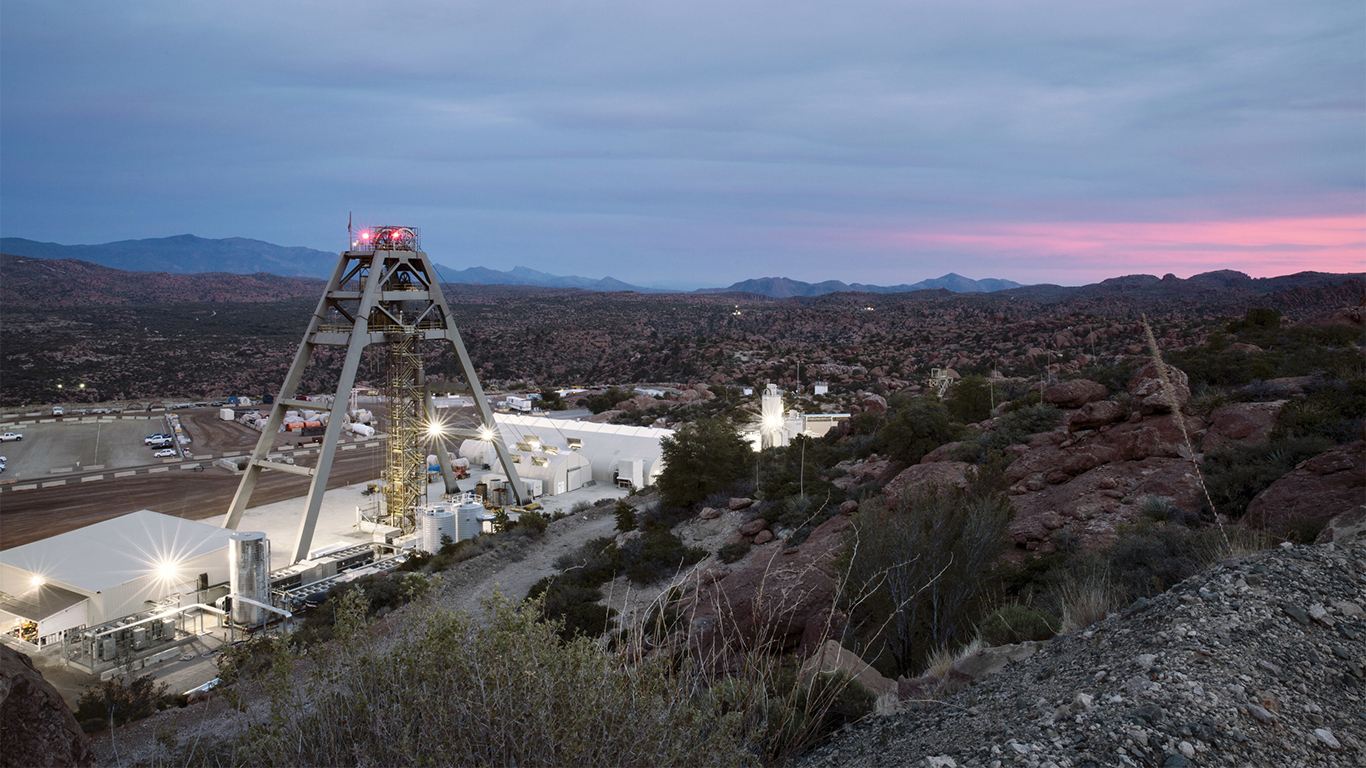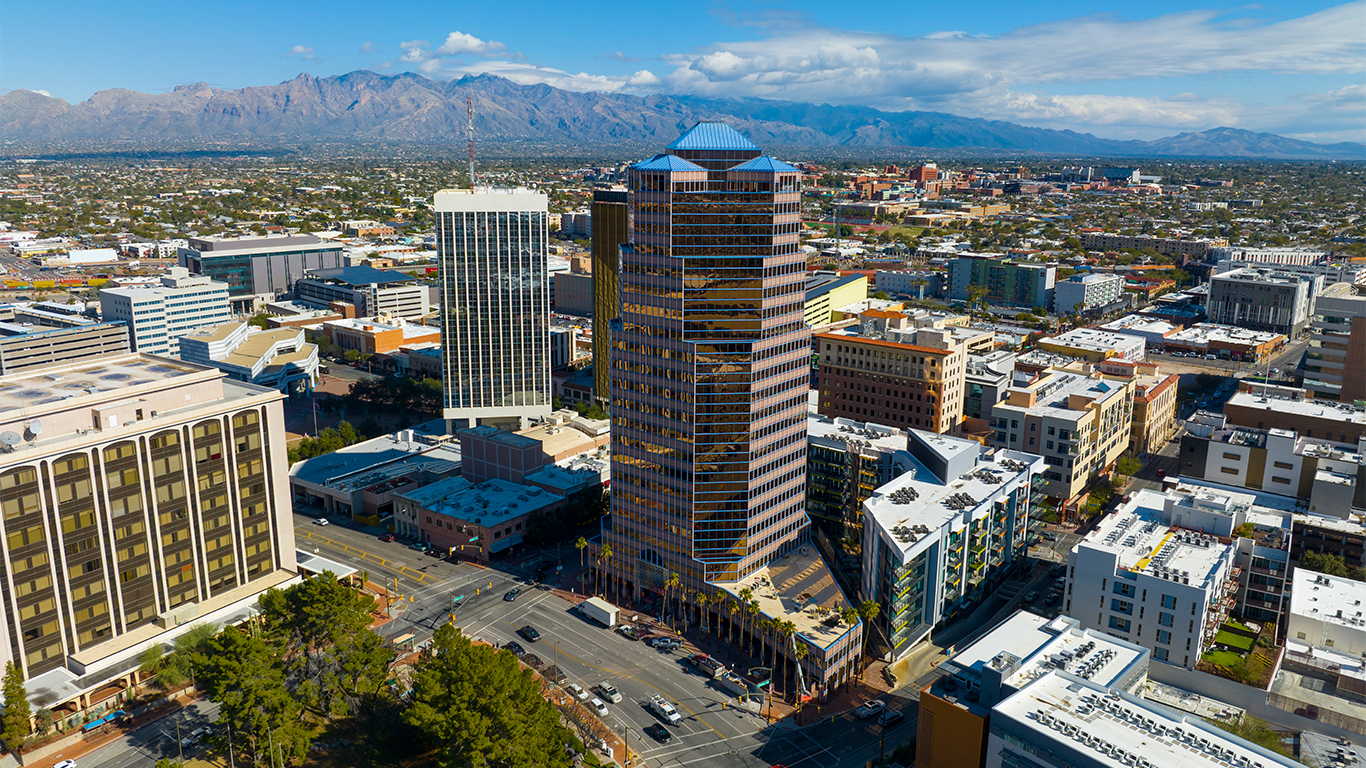The Tucson and Southern Arizona economic outlook for 2025 is characterized by steady, albeit modest, growth. The Southern Arizona economy is projected to expand, driven primarily by net migration, with Tucson’s population expected to increase by 0.8% in 2025, according to research from the Eller College of Management. Job growth is anticipated to be around 1% annually, which, while slower than the state average, still surpasses national rates, according to Eller research.
Key sectors contributing to this growth include healthcare, education and logistics, bolstered by institutions like the University of Arizona and events such as the Tucson Gem, Mineral, and Fossil Showcase, which injects over $130 million into the local economy annually. However, challenges persist, including housing affordability concerns and a slower economic expansion compared with other Arizona regions. Despite these hurdles, the region’s diverse economic base and ongoing investments in key industries position it for continued, if measured, growth in the coming years.
LOCAL NEWS: 100 best places to work and live in Arizona for 2025
INDUSTRY INSIGHTS: Want more news like this? Get our free newsletter here
Batteries spark Southern Arizona economy
One key element driving that continued economic growth is the emergence of Southern Arizona as a hub for battery manufacturing, driven by significant investments and strategic initiatives.
A pivotal development is the construction of American Battery Factory’s (ABF) 2 million-square-foot lithium iron phosphate (LFP) battery cell gigafactory in Tucson. This facility, set to be the largest of its kind in the United States, represents a $1.2 billion investment and is projected to create up to 1,000 jobs, contributing approximately $3.1 billion in economic impact to Arizona.
“In support of battery manufacturing, we will travel to the Battery Show, which is one of the large battery-related industry events,” says Kevin Burke, deputy director of the Office of Economic Initiatives for Tucson. “We also attended SPIE, International Society for Optics and Photonics.”
Burke adds, “We’re expecting [ABF] to break ground in the next couple of weeks. We’ve had a lot of interest from other battery manufacturers and we’re confident that we will turn some of those into actual projects as well.”
Several factors contribute to Southern Arizona’s attractiveness for battery manufacturing:
• Strategic location: Tucson’s proximity to major transportation routes and the U.S.-Mexico border facilitates efficient distribution and logistics.
• Skilled workforce: The presence of institutions like the University of Arizona, Central Arizona College and Pima Community College ensures a pipeline of qualified professionals in engineering and technology fields.
• Supportive policies: Local incentives, such as Tucson’s Primary Jobs Incentive, offer benefits like construction sales tax reimbursements and job training support, making the region more appealing to manufacturers.
• Environmental commitment: Tucson’s declaration of a “climate emergency” and commitment to carbon neutrality by 2030 align with the clean energy goals of battery manufacturers.
Additionally, ABF’s partnership with KAN Battery aims to refine LFP cell production, bringing advanced manufacturing techniques to the Tucson facility and enhancing the region.

“The Resolution Copper mine is vital to securing America’s energy future and infrastructure needs with a domestic supply of copper and other critical minerals,” says Vicky Peacey, general manager at Resolution Copper. “We are encouraged by the strong community and regional support for the project which has the potential to be one of America’s biggest copper mines, add $1 billion a year to Arizona’s economy, and create thousands of local jobs in a region where mining has played an important role for more than a century.” (Photo provided by Resolution Copper)
Education drives jobs
One major milestone in strengthening Southern Arizona’s future workforce was the recent opening of the battery-focused Future48 Workforce Accelerator in Pinal County. Led by the members of LG Energy Solution, the Accelerator will provide hands-on training for future battery professionals who will take part in LG Energy Solution’s commitment to U.S. electrification and also support the state’s growing battery manufacturing industry.
LG Energy Solution is still in the construction phase with its $5.5 billion battery manufacturing facility in Queen Creek, where the regional workforce trained through the Accelerator will start their careers into the next-generation battery industry. As the company’s first cylindrical battery plant in the U.S., the facility will deliver its state-of-the-art 46-Series cylindrical batteries to renowned automakers, bringing well-paying, high-quality jobs to the community along the way.
“By expanding workforce development, we are creating pathways for more Arizonans to realize the Arizona Promise,” says Gov. Katie Hobbs. “Our Future48 Workforce Accelerators are a shining example of how collaboration advances our efforts to equip Arizonans with the skills and training they need to succeed. This new accelerator will further grow our talent pipeline and fill in-demand jobs that strengthen families and our economy.”
Located at Central Arizona College’s Superstition Mountain Campus in Apache Junction, the 19,850-square-foot Accelerator will provide workforce training focused on the manufacturing process of cylindrical batteries used for electric vehicles and other applications. Specifically, as the program is designed to develop regional talent who will join LG Energy Solution’s Queen Creek facility after completion, members of LG Energy Solution Arizona will provide hands-on training for the facility’s manufacturing equipment and safety processes and incorporate simulation technology for personnel training.
“The Future48 Workforce Accelerator will not only expand workforce training opportunities focused on battery manufacturing and hands-on training for LGES but will allow CAC to expand educational opportunities for students to learn the latest LGES manufacturing technology from industry experts,” says Dr. Jackie Elliott, president and CEO of Central Arizona College. “We are excited to see the progress of the LGES training program and celebrate the successes of the first cohort of graduates.”
The battery-focused Future48 Workforce Accelerator marks the second training center launched in partnership with Central Arizona College and Pinal County. In 2021, Arizona launched Drive48, the inaugural Future48 Workforce Accelerator, an automotive training assembly facility in Coolidge with partners including the ACA, Central Arizona College, Pinal County, the City of Casa Grande, and Lucid. Drive48 features multiple assembly robots and individual training rooms to prepare students for jobs in automotive assembly manufacturing.
“We will create 1,500 new employment opportunities overall by 2027, significantly thriving the local economy and further cementing Arizona’s growing reputation as a hub for advanced manufacturing,” says Richard Ra, president of LG Energy Solution Arizona. “This workforce training center at CAC will be a cornerstone of our effort, preparing a highly skilled workforce for the jobs of tomorrow for Arizonans by awakening their infinite potential.”
The Future48 Workforce Accelerators are modeled after the successful Drive48 facility in Pinal County. Since launching in 2021, more than 2,000 students have graduated from the program, with many currently working at Lucid’s Advanced Manufacturing Plant in Casa Grande.
“We’re incredibly to launch another Future48 Workforce Accelerator,” says Sandra Watson, president and CEO of the Arizona Commerce Authority. “The battery-focused Accelerator will play a critical role in equipping students with the skills needed for battery manufacturing careers in Arizona, where we have thousands of new jobs coming online.”
Resolution Copper’s partnerships with educational partners (and community stakeholders) such as Superior Unified School District, Superior Chamber of Commerce, Rebuild Superior Inc., the Town of Superior, Globe Unified School District Robotics, Queen Valley Fire Department and the Superior Fire Department has proven useful in supporting the growth of skilled talent.
“We have provided $1.2 million of funding over four years for STEM and robotics programs in the Superior Unified School District,” says Tyson Nansel, principal advisor of communications for Resolution Copper. “Since 2002, we’ve awarded over $850,000 in scholarships to more than 250 local students, helping to ensure that today’s students become tomorrow’s skilled professionals in Arizona’s mining industry. Lastly, our recent Resolution Copper Apprentice Program is designed to provide the training for all these positions to be filled locally.”
Commercial property activity
While new battery facility projects are booming throughout Southern Arizona, real estate development in other markets also continues to grow.
Burke explains that Tucson is using Government Property Lease Excise Tax (GPLET) to encourage new development by reducing property taxes for developers who improve property values significantly.
“We approved a number of mixed-use projects that essentially are incentivized because the way the GPLET works,” Burke explains. “[Project owners] construct the project when the certificate of occupancy is issued, they deed that property over to the city. The city takes ownership for a period of up to eight years, and because the city is the owner of the property, it’s no longer subject to ad valorem tax.”
Many of the GPLET mixed-use and residential construction projects are centered in Downtown Tucson, supported by the city. “The mayor and council recently adopted a new zoning designation,” Burke says. “We call it the CCT or the Community Corridors Tool. That Community Corridors Tool is a wholesale upzoning for commercial properties across the city.”
Other Southern Arizona regions are also bolstering downtown commercial projects. Yuma is targeting redevelopment in its downtown corridor, offering incentives to attract commercial investment. Sierra Vista is focusing on adaptive reuse and infill commercial development downtown.
“The demand for well-managed, high-integrity commercial projects keeps our teams busy across multiple sectors,” notes Nate Lowrie, CEO and owner of Bjerk Builders, “especially when our partners want to upgrade or expand intelligently. We have a great state and great people building trust and long-term partnerships.”
Infrastructure investments
An integral component of overall growth in Tucson is its infrastructure.
“We’ve been able to construct infrastructure commensurate with the population growth,” Burke says.
Tucson’s infrastructure expansion and improvements within the state of Arizona, according to Burke, have historically been incredibly disadvantaged in the share of infrastructure dollars that have flowed to Southern Arizona versus those allocated to Maricopa County. As a result, the city has found creative means of funding much-needed infrastructure revitalization,
“The Tucson community has voted in favor of taxing ourselves to pay for infrastructure,” Burke says. “The first was for public safety infrastructure. The other was specifically for roadway reconstruction and resurfacing throughout the city.”
Over the next six years, Tucson plans to make significant progress on repaving all neighborhood streets, collector roads and arterial roads in the city.
Resolution Copper’s billion-dollar potential
Resolution Copper released two major and exciting announcements in April, which will help move the Superior mining project one step closer to feeding $1 billion into the Southern Arizona economic pipeline annually.
The first announcement revealed that the U.S. Forest Service issued a legally required 60-day notice of the agency’s intent to republish a Final Environmental Impact Statement (FEIS) for the Resolution Copper project. This is a positive step forward for the Resolution Copper project after more than a decade of rigorous, independent review and consultation with local communities and Native American tribes.
Once all final permits are obtained, the project will create economic opportunities for the Town of Superior and the entire Copper Triangle region as one of the largest investments in rural Arizona. The Town of Superior will be granted land from the Federal government to use for economic expansion and diversification opportunities.
The other significant news came from a White House announcement, designating the Resolution project as part of the Federal Permitting Improvement Steering Council’s list of critical mineral “transparency projects.”
“Resolution Copper is one of the largest investments in Arizona’s history and will create economic opportunities for the Town of Superior and the entire Copper Triangle region, adding up to $1 billion a year to Arizona’s economy and creating thousands of good-paying jobs,” Nansel says. “Third-party studies have demonstrated that Resolution Copper could produce up to $61 billion in economic value for Arizona over the life of the project.”
Additionally, Resolution Copper has the potential to employ 1,500 workers in Arizona, with an estimated $134 million per year in total compensation. It will also generate approximately 2,200 indirect jobs, with an estimated $136 million in compensation, meaning it could support some 3,700 jobs and $270 million per year in total compensation at full production.
Additionally, according to Nansel, Resolution Copper continues to prioritize economic growth by keeping jobs local and supporting surrounding communities. By prioritizing local hiring and partnering with area businesses, Resolution Copper is demonstrating its commitment to building a resilient, interconnected economy. Success stories like Oddonetto Construction, 4-Winds Contracting and Superior Environmental — businesses that have expanded with the project’s support — reinforce this and highlight the positive impact of Resolution Copper and its partnerships.
“We are committed to local vendors and hiring — more than 90% of the current 300 employees and contractors at Resolution Copper live within 40 miles of the project,” Nansel adds, “which will certainly provide a long-term investment in the region.”




